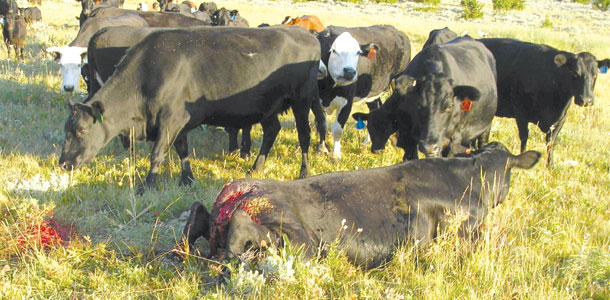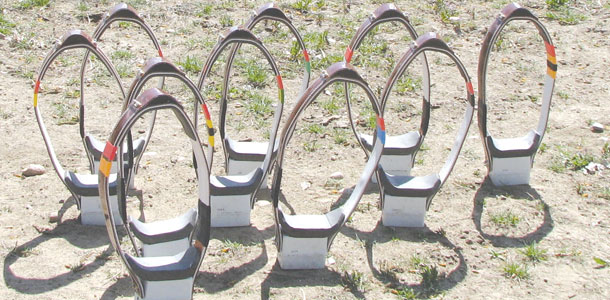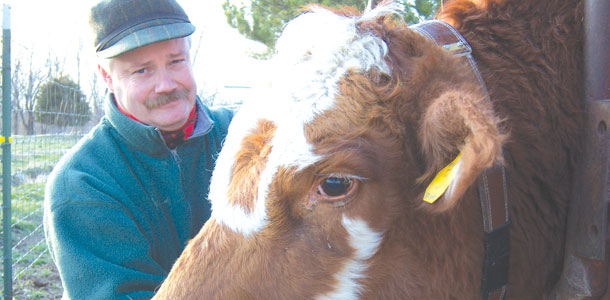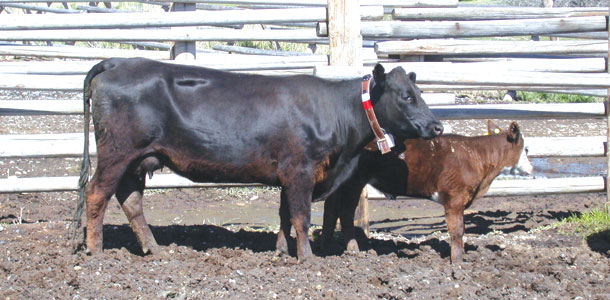The Oregon Beef Council (with help from the USDA) funded a long-term study project, beginning in 2008, to see how wolf activity affects cattle behavior.

GPS collars are being used on cattle from several ranches, and a few wolves, to monitor movements of these animals and when and where they interact.
The initial goal was to learn what to expect in Oregon judging by what had already happened in Idaho.
The Oregon Beef Council wanted to collect data in a high-wolf population area in Idaho and compare it with data from an Oregon area with similar terrain and management.

They paired several ranch sites in Idaho with ranches in Oregon that did not have wolves yet. Range scientists from Oregon State University, University of Idaho, the Agricultural Research Service (ARS-USDA) and personnel from Idaho Fish and Game are involved with this study.
Not long after the study began, a wolf pack moved into an area near Enterprise, Oregon. So the program took a shift from comparing high wolf pressure with no wolf pressure to comparing high wolf pressure with low wolf pressure.
The researchers collared 10 cows on each paired ranch – in Idaho and Oregon. They wanted to get a baseline on how cattle use the terrain, and if they use it differently or change behavior patterns when there are wolves.

Doug Johnson, Department of Rangeland Ecology and Management, Oregon State University (Corvallis), says cow collars were retrieved from the 2012 and 2013 grazing seasons.
“We log data at high frequency, usually recording the location every five minutes. This gives us a good idea about where the cows go and how much time they spend in various activities,” he says.
This study has already provided insight on behavior of cattle regarding site selection and where they like to go, and their interaction with wolf packs.
“One wolf was tracked, at 15- minute intervals, for 210 days during 2012,” says Johnson.
That one wolf came into close contact with all 10 collared cows 783 times. This wolf was a member of a 12-wolf pack.
The 10 collared cows were in a herd of 450 head. Envision a herd of 450 cows with 12 wolves moving amongst them, and multiply 783 by 12 wolves, and multiply that by 450 – and that’s how many encounters those cattle had with wolves that summer. The cows were constantly affected by the presence of wolves.
“We get a lot of data from the cattle collars. For instance, the ranch where this wolf was traveling turns cattle out on the range in March and gathers them in October, which gives us half a million data points per grazing season from that ranch,” he says.

Neil Rimbey, range economist with University of Idaho, has been evaluating the economic impact on ranches in the study.
“I talked with ranchers and gathered information that we’ve used in creating representative ranch budgets. We are using this to develop economic models to assess the economic impact of management alternatives.”
The depredation loss (direct losses in killed animals) is what gets attention, but this study has already shown that some of the indirect losses actually have more impact on ranch profitability and sustainability.
“In a study in Lemhi County, Idaho, about 10 years ago, the calves on one allotment were tagged with special tracking devices at the time they were turned out.
In this study, we were only able to actually find one out of every five calves that disappeared. In rugged country, this is typical,” says Rimbey.
“A more recent study in Wyoming indicated that this rate was actually low; in that state they are compensating ranchers on a one-to-seven basis (figuring a rancher will only be able to find and confirm one out of every seven animals killed by wolves).
This recent research in Wyoming also suggests that some of the indirect losses – more open cows, reduction in weight gain on calves, more veterinary treatments for injured calves or stressed calves that got pneumonia – should raise the compensation rate (from one-to-seven) up to one-to-13 or one-to-14,” Rimbey says.
Change in cattle behavior in the presence of wolves not only affects the cattle but also impacts management and is harder on the land and facilities.
Cattle don’t stay where they are put – coming right back down off the mountains to try to get away from wolves. They may use some areas more heavily while avoiding others. Cattle also crash through fences and are harder to handle.
“Oregon and Idaho ranchers have mentioned increase in time, labor and costs associated with managing cattle.
There’s more travel involved when dealing with distant areas; they have to go more frequently to try to check the cattle.
They have to spend more time meeting with Fish and Wildlife Service to try to get confirmation on death loss, etc.” This becomes a drain on time and energy.
“These are some of the things we are looking at. Most people don’t realize the extent of these impacts. Some ranchers mention cattle being more difficult to manage,” Rimbey says.
They can’t bring dogs when working cattle; the cattle just keep attacking the dogs. The cattle also attack a person on foot.
“With the budget information we’ve gathered, we’ll develop models and impose different things on that model.
We can calculate what happens if death loss goes from 2 percent to 8 percent, or what happens if the ranch has to hire another rider in the summer, etc.”
The study has helped confirm things ranchers have suspected regarding behavioral changes in cattle, and it will be interesting to see how the economic impacts calculate out.
“For instance, each 1 percent change in percent of calves weaned in Idaho (using conservative prices) is amounting to about a $1,750 change in gross revenue, or nearly $6 per cow. This is just a starting point of this component of the project,” says Rimbey.
Montana ranchers are also suffering losses from the expanding wolf populations. Ross Middlemist, a rancher near Dixon, Montana, began noticing wolves with his cattle about 12 years ago, and then lost a pregnant 2-year-old heifer three years ago.
“Neighbors told me they could always tell if wolves were around, just by the behavior of their cattle. The cows refuse to go back to the higher country.
This is a challenge for us, anyway, because our water is too low on one draw, and we have trouble keeping the cattle higher,” he says.
It helped when the wolves in Montana were finally delisted, and it became legal to shoot any that are harassing livestock.
“I’m still unable to use some of our pastures, however, because of the risk. We have one pasture that we didn’t use for spring grazing with baby calves for several years.
We put some yearling heifers up there last spring and got away with that, and put some dry cows up there late in the fall. But the wolves are dictating how we use our own land,” says Middlemist.
This can seriously impair management. It really hurts when a person can’t use certain pastures when they need to be used, or has no peace of mind when trying to use pastures where there is risk for wolf depredation.
“For three years, I refused to put cows and babies up there, so the only option was to feed more hay. No one has offered to help with the added expenses, even though they are using our land to produce wolves.” ![]()
PHOTOS
PHOTO 1 and 2: In these photos from a Wyoming hunter, a female near Cody, Wyoming, is shown after an attack by a wolf pack. The wolves left after gunfire, but they returned after the hunter left. Photos by Len Fortunato/Courtesy Heather Thomas.
PHOTO 3 : A selection of collars to be placed on cattle in the USDA study.
PHOTO 4: Cows collared in the USDA study are monitored for their interactions and movements related to wolves.
PHOTO 5: A cow with her calf will be tracked with high-frequency recording of its motions every five minutes. Photos by Pat Clark/USDA-ARS.








